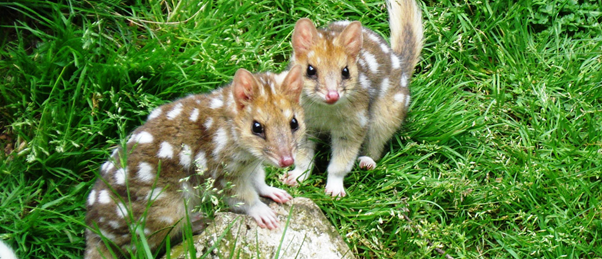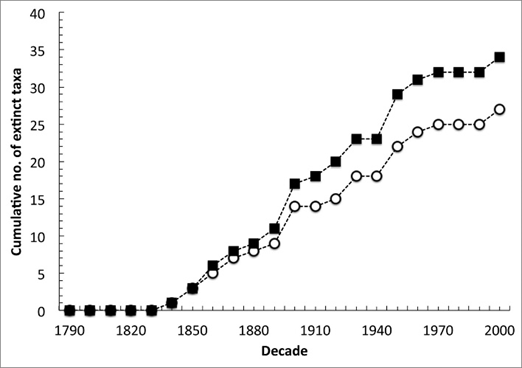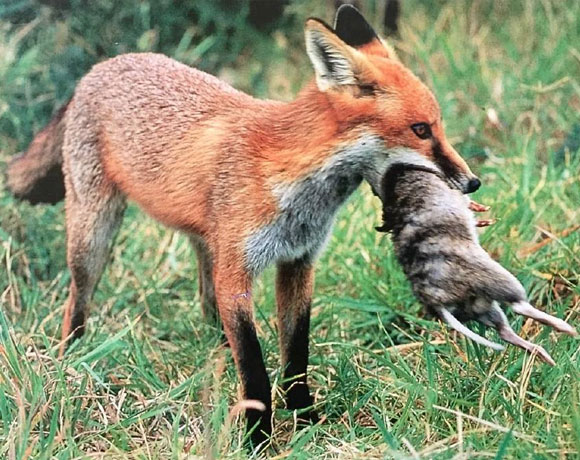Samuel Phillis u5820978
An Interview with Belinda Wilson – Conservation Ecologist, and PhD Candidate at the Fenner School of Environment and Society at the Australian National University on the reintroduction biology of the eastern quoll.

Australia holds many records, but probably the least flattering is our record for the most mammal extinctions in the world. With 34 mammals lost since European settlement, Australia claims over 1/3 of the world’s mammal losses. Combating the continued effects of human civilisation on biodiversity is a monolithic challenge, however continued research and conservation efforts are yielding results that may help mitigate these impacts.

Graph produced by Woinarski JCZ, Burbidge AA, Harrison PL (2014) The Action Plan for Australian Mammals 2012 (CSIRO Publishing, Melbourne)
Loss of the eastern quoll
Around 60 years ago, the eastern quoll (Dasyurus viverrinus) went extinct on the Australian mainland, disappearing from the Australian Capital Territory nearly 80 years ago, succumbing to invasive species predation, disease, and human habitat destruction and persecution. Recently however, efforts to reintroduce the species into the Mulligans Flat Woodland Sanctuary in the ACT have met great success!
Why Mulligans Flat?
Mulligans Flat is “a really good spot” says Belinda Wilson, a PhD Candidate from the ANU who has been working tirelessly on the reintroduction, which she describes as the “intentional movement of an organism within its historical range”.
Mulligans Flat is equipped with “a predator proof fence… about 11.5km” long and protects ~485ha of Box Gum Grassy Woodland, a critically endangered ecological community, having lost >95% of its extent. This makes it a perfect sanctuary for the eastern quoll’s reintroduction, protecting them from invasive predators like foxes, and allowing them to be monitored and studied ensuring their continued survival.
Key Threats
Wilson described the threats the eastern quoll faces as being continued predation from foxes and invasive species, as well as disease, and human persecution, noting that climate change induced drought may pose a persistent threat to the species. The aim is to expand the species from Mulligans flat so continued efforts to mitigate the impact of invasive predators will be paramount for the survival of not only the eastern quoll, but many Australian species. According to the NSW Department of Primary Industry, Foxes can have a density of up to 5/km2 in the regions around Canberra, and up to 12/km2 in peri-urban and urban areas.
“Beyond the fence, by far, the biggest issue would be foxes”
Belinda Wilson

– available at
https://rewildingaustralia.org.au/wp-content/uploads/2019/04/Fox_Kill_580x460.jpg
Threat Mitigation
To mitigate this, Wilson set the goal of minimising the eastern quolls’ dispersal as “the less they disperse, the less likely they go over the fence and get taken by foxes”. The first reintroduction had an effective success rate of just 23% in 2016, but through “manipulating tactics… like timing” or where the quolls were released, as well as reintroducing a higher number of females with pouch young, rather than males which “disperse further and have larger home ranges”, Wilson was able to raise that statistic to 77%”
Future Quoll-ity
The reintroduction of the eastern quoll to the ACT is a rare success story, but gives hope that we can change our tune as a country and begin protecting, and hopefully even restoring, our country’s astounding biodiversity. Limiting habitat destruction, developments near threatened ecosystems or species, and by better managing invasive species and predators, we may just be able to slow our horrifying mammal extinction rates. Couple this with greater governmental prioritisation of conservation, increased funding, and research approvals, our conservational ecologists may just stand a chance of helping our country progress, whilst protecting our unique ecosystems.
If you are interested in volunteering opportunities at Mulligans Flat head to https://mulligansflat.org.au/volunteer-2/
